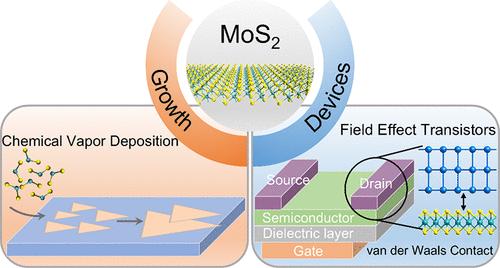当前位置:
X-MOL 学术
›
Acc. Chem. Res.
›
论文详情
Our official English website, www.x-mol.net, welcomes your
feedback! (Note: you will need to create a separate account there.)
Mechanisms of Controllable Growth and Ohmic Contact of Two-Dimensional Molybdenum Disulfide: Insight from Atomistic Simulations
Accounts of Chemical Research ( IF 16.4 ) Pub Date : 2024-10-11 , DOI: 10.1021/acs.accounts.4c00495 Liang Ma, Xiaoshu Gong, Ruikang Dong, Jinlan Wang
Accounts of Chemical Research ( IF 16.4 ) Pub Date : 2024-10-11 , DOI: 10.1021/acs.accounts.4c00495 Liang Ma, Xiaoshu Gong, Ruikang Dong, Jinlan Wang

|
Two-dimensional (2D) semiconducting transition metal dichalcogenides (TMDs), in particular molybdenum disulfide (MoS2), have recently attracted huge interest due to their proper bandgap, high mobility at 2D limit, and easy-to-integrate planar structure, which are very promising for extending Moore’s law in postsilicon electronics technology. Great effort has been devoted toward such a goal since the demonstration of protype MoS2 devices with high room-temperature on/off current ratios, ultralow standby power consumption, and atomic level scaling capacity down to sub-1-nm technology node. However, there are still several key challenges that need to be addressed prior to the real application of MoS2-based electronics technology. The controllable growth of wafer-scale single-crystal MoS2 on industry-compatible insulating substrates is the prerequisite of application while the currently synthesized MoS2 films mostly are polycrystalline with limited sizes of single-crystal domains and may involve metal substrates. The precise layer-control is also very important for MoS2 growth since its electronic properties are layer-dependent, whereas the layer-by-layer growth of multilayer MoS2 dominated by the van der Waals (vdW) epitaxy leads to poor thickness uniformity and noncontinuously distributed domains. High density up to 1013 cm–2 of sulfur vacancies (SVs) in grown MoS2 can cause unfavorable carrier scatting and electronic properties variations and will inevitably disturb the device performance. The dangling-bond-free surface of MoS2 gives rise to an inherent vdW gap at metal–semiconductor (M–S) contact, which leads to high electrical resistance and poor current-delivery capability at the contact interface and thereby substantially limits the performances of MoS2 devices.
中文翻译:

二维二硫化钼的可控生长和欧姆接触机制:来自原子模拟的见解
二维 (2D) 半导体过渡金属二硫化物 (TMD),特别是二硫化钼 (MoS2),由于其适当的带隙、二维极限下的高迁移率和易于集成的平面结构,最近引起了极大的兴趣,这对于在后硅电子技术中的摩尔定律的扩展非常有希望。自从展示具有高室温开/关电流比、超低待机功耗和原子级缩放能力低至 1 纳米技术节点的 proType MoS2 器件以来,人们为实现这一目标付出了巨大的努力。然而,在真正应用基于 MoS2 的电子技术之前,仍有几个关键挑战需要解决。晶圆级单晶 MoS2 在工业兼容的绝缘衬底上的可控生长是应用的先决条件,而目前合成的 MoS2 薄膜大多是多晶,单晶畴尺寸有限,可能涉及金属衬底。精确的层控制对于 MoS2 的生长也非常重要,因为它的电子特性是分层依赖性的,而以范德华 (vdW) 外延为主的多层 MoS2 的逐层生长导致厚度均匀性差和非连续分布畴。生长的 MoS2 中高达10 13 cm–2 的硫空位 (SV) 密度高,会导致不利的载流子脱落和电子特性变化,并且不可避免地会干扰器件性能。 MoS2 的无悬铆接表面在金属-半导体 (M-S) 接触处产生固有的 vdW 间隙,这会导致接触界面处的高电阻和较差的电流传输能力,从而大大限制了 MoS2 器件的性能。
更新日期:2024-10-12
中文翻译:

二维二硫化钼的可控生长和欧姆接触机制:来自原子模拟的见解
二维 (2D) 半导体过渡金属二硫化物 (TMD),特别是二硫化钼 (MoS2),由于其适当的带隙、二维极限下的高迁移率和易于集成的平面结构,最近引起了极大的兴趣,这对于在后硅电子技术中的摩尔定律的扩展非常有希望。自从展示具有高室温开/关电流比、超低待机功耗和原子级缩放能力低至 1 纳米技术节点的 proType MoS2 器件以来,人们为实现这一目标付出了巨大的努力。然而,在真正应用基于 MoS2 的电子技术之前,仍有几个关键挑战需要解决。晶圆级单晶 MoS2 在工业兼容的绝缘衬底上的可控生长是应用的先决条件,而目前合成的 MoS2 薄膜大多是多晶,单晶畴尺寸有限,可能涉及金属衬底。精确的层控制对于 MoS2 的生长也非常重要,因为它的电子特性是分层依赖性的,而以范德华 (vdW) 外延为主的多层 MoS2 的逐层生长导致厚度均匀性差和非连续分布畴。生长的 MoS2 中高达10 13 cm–2 的硫空位 (SV) 密度高,会导致不利的载流子脱落和电子特性变化,并且不可避免地会干扰器件性能。 MoS2 的无悬铆接表面在金属-半导体 (M-S) 接触处产生固有的 vdW 间隙,这会导致接触界面处的高电阻和较差的电流传输能力,从而大大限制了 MoS2 器件的性能。






























 京公网安备 11010802027423号
京公网安备 11010802027423号